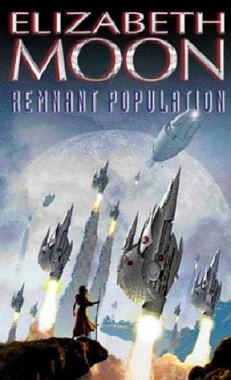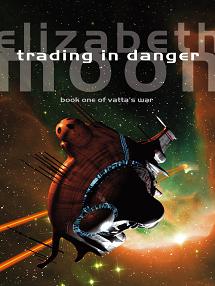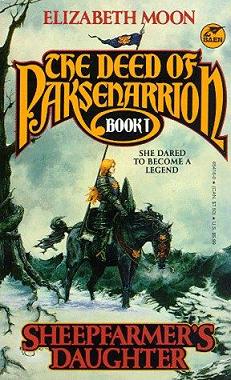
Remnant Population
Elizabeth Moon
360 pages
published in 1996
Elizabeth Moon is a writer I didn’t pay much attention to until a year or two ago. I’d read one or two of her books and they were competently written military science fiction, better written than those of a David Weber or John Ringo, but nowhere near as good as Lois McMaster Bujold’s. When I decided I needed to read more female science fiction writers, Moon was one of the writers I was giving a second chance. Since then I’ve read roughly half a dozen or so of her novels and my initial impression of her has remained roughly the same. She’s a better writer than she needs to be to sell the sort of stories she usually writes and there’s a bit of hidden depth in her mil-sf stories that’s missing from many of her colleagues, that hint at a greater potential. Yet she seems content to keep on writing the same sort of adventure science fiction and fantasy.
Not always though. On two occasions Moon has attempted to write something else than military science fiction, something more ambitious. The most well known of these two novels is of course her Nebula and Arthur C. Clarke winning 2002 novel, Speed of Dark. The other one is Remnant Population, which is a novel about First Contact, between the hitherto unknown indigenous population of an alien planet and the last remaining inhabitant of a failed human colony. As such, it’s a good case study of Moon’s strengths and weaknesses.
To start with the good bits: the protagonist Ofelia, a cantankerous widowed peasant woman not very enamoured of her youngest child and his wife she’s stuck living with. They’re controlling and bossy, always trying to get her to conform to their ideas of what a respectable widow should look and act like. Coming from a conservative society Ofelia has had more than enough of this her entire life. She resists this the way peasant women have forever, through passive resistance and going her own way as much as she can. It’s the same way in which she avoids being taken aboard the evacuation ship when the colony is abandoned, simply by not being there when the ship takes off.
Throughout the next part of the book, as Ofelia struggles to establish her new life alone and starts enjoying herself, we get to know more of her life before she came to this planet, on another colony world; Earth isn’t mentioned and it’s unclear how long humanity has been colonising other systems. It’s clear, both from what Ofelia tells about her life in the colony as on her homeworld that the society she grew up with, despite having star travelling technology is a conservative one, with a large base of only semi-educated peasants to which Ofelia and her parents belong, very much a “traditional” patriarchy, vaguely Latin American in flavour, though that may just be me. Besides this there’s also a much more technocratic, gender equal, westernised elite that works for the companies and the military. Ofelia doesn’t have much truck for them, as these tend to patronise her as much as her family attempted to control her. She’s glad to be finally alone and beyond the control of either of them.
Ofelia doesn’t stay alone for long; new colonists from a different company show up to reclaim the planet while pretty soon it’s also clear that there is actually indigenous intelligent life on the planet. When the new colonists land on a different continent they’re attacked and killed by these aliens, with Ofelia following everything on the radio. Ever since then she lives in fear the aliens will track her down and kill her too and indeed her worst fears seem to be confirmed when they do show up in her village.
It turns out that the aliens are a lot less hostile than their earlier actions suggested and Ofelia now has to learn to live with them and teach them, something she’s not that enthusiastic about, though gets to appreciate more once she gets used to them. For me it would’ve been perfect had the rest of the book explored the first contact and building up of trust and genuine friendship between Ofelia and the aborigines with their “stone age”, pre-literate oral culture, but Moon felt it necessary to complicate the story by having a human expedition return to Ofelia’s world.
This is probably Elizabeth Moon’s greatest weakness: she can’t write a story without overt conflict for which she needs a villain. In this case the villains are the members of the expedition back to Ofelia’s world, there to determine whether the aborigines are really intelligent and what to do about them. They’re smug, patronising to Ofelia and much much dumber than they themselves realise. While Ofelia manages to establish genuine contact with the aliens, learning to slowly speak their language, the expedition dissolves in petty squabbles, threatening the trust Ofelia had managed to build. In other words, the author’s thumb is very much on the scale at Ofelia’s side.
Making the newcomers more stupid than they should be, making these highly educated and smart specialists too dumb to find their backsides with a map, a compass and a flashlight, cheapens the story. It does fit the overall theme of the story though, which consistently puts Ofelia’s “uneducated” peasant wisdom against the book learning of her social superiors. It’s a deeply conservative message, which isn’t all that surprising coming from Elizabeth Moon, whose writing always has been a bit on the conservative side. The only problem with this here is that she basically has Ofelia defeat straw men, the plot didn’t need these cardboard villains.
Remnant Population then is a flawed but interesting attempt by Moon to write something deeper than the military adventure sf stories she usually writes. It’s unfortunate that she led her worst instincts to take over the last third of so of the story to introduce unnecessary conflict.

